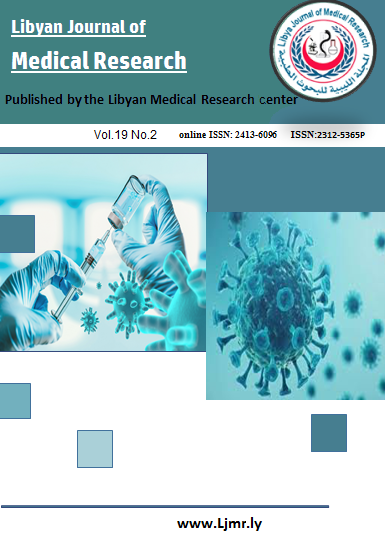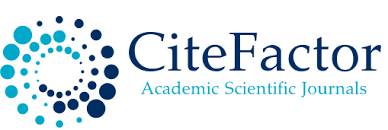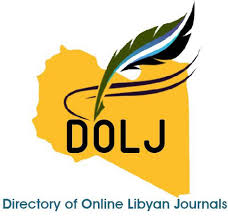Emergence of Urogenital Schistosomiasis Cases in Southwest Libya: Evaluation and Management
DOI:
https://doi.org/10.54361/LJMR.10.2.19Keywords:
Hematuria, Schistosoma haematobium, Bilharzial Cystitis, Urogenital Schistosomiasis, praziquantelAbstract
Background: Schistosomiasis is an infection caused by a parasitic worm that lives in fresh water throughout Africa. In many tropical and subtropical regions, including Libya, urogenital schistosomiasis is regarded as one of the neglected tropical illnesses. In Libya, the first known instance of schistosomiasis was in 1925. Since 2003, the prevalence of focally endemic Schistosoma haematobium and Schistosoma mansoni in Libya has been estimated at 5%. Aim: The primary goal of this study is to explore the emergence of bilharzial cystitis cases in southwest Libya and to evaluate current diagnostic and management approaches. Material and methods: 28 patients with belharzial cystitis were diagnosed at the Al Rahma Poly Clinic in Sabha City, Libya between February 2020 and August 2024, and were analyzed. Patient demographics, clinical presentations, laboratory findings, and treatment outcomes were reviewed. Results: the ages of the 28 patients in this study ranged from 9 to 65 years old (mean: 18.96 ± 10.64 years). The majority were Libyan (82.14%), while 17.86% were non-Libyan (from Niger and Chad). Following treatment with a single dose of praziquantel (40 mg/kg), only one patient (3.5%) exhibited persistent hematuria, and two (7.1%) had dysuria at one-month follow-up. Additionally, 3.5% had persistent bilharzial eggs in urine, 39.2% had persistent RBCs, and 21.4% had pus cells. Urogenital schistosomiasis remains hypoendemic in several Libyan regions. Conclusion: our data showed that both surveillance and management programs are necessary to detect and handle these occurrences. This can easily be achieved by focusing on snail control, praziquantel chemotherapy, public health education, and access to clean water. Schistosomiasis should be considered as a differential diagnosis for hematuria in endemic regions.
Downloads
References
1. Barsoum RS, Esmat G and El-Baz T. Human schistosomiasis: clinical perspective. Journal of advanced research. 2013; 4(5) :433-444.
2. Santos LL, Santos J, Gouveia MJ, Bernardo C, Lopes C, Rinaldi G, Brindley PJ and Costa JMCD. Urogenital Schistosomiasis-History, Pathogenesis, and Bladder Cancer. J Clin Med. 2021;10: (2):205.
3. Barakat R, EL Morshedy H, and Farghaly A. Human Schistosomiasis in the Middle East and North Africa Region. In: McDowell, M., Rafati, S. (eds) Neglected Tropical Diseases - Middle East and North Africa. Neglected Tropical Diseases. Springer, Vienna. 2014. https://doi.org/10.1007/978-3-7091-1613-5_2
4. El-Gíndy MS, El-Edríssy AW. Present situation of schistosomiasis in the Libyan Arab Republic. I. Bilharziasis in Ubari District in Fezzan (Sebha Governorate. Egypt J Bilharz. 1975;2(1):117-30. PMID: 1181169.
5. Mohmmed S, El-Muzghi A. Vector-Borne Parasitic Diseases: Climate Change, Non-Climate drivers and Immunity. 2022. Vol. 2
6. SWEHLI AI. A study of the environmental aspects of schistosomiasis in Libya (Snils, parasites, Diseases). Western Michigan University. (1983).
7. Bergquist R. Strategies for control of infection and disease: current practice and future potential. Schistosomiasis. Imperial College Press: London. 2001; 413-467.
8. Hafeez K, Ibrahim S A, Omran M A and Mohammed Y E. Urinary Schistosomiasis in Sebha, Libya. Sebha Medical Journal. 2007; 6(1)
9. Saadawi WK, Gashout AS, Aldobea NM, Amro AY and Annajar BB. Urogenital Schistosomiasis in Libya, a Case Report and Evaluation of the Current Situation. Libyan Journal of Medical Sciences. 20215; (2):93-95
10. Nagi M. Evaluation of a programme for control of Schistosoma haematobium infection in Yemen. East Med Health J. 2005; 11: 977–987
11. Raja'a YA, Assiragi HM, Abu-Luhom AA, Mohammed AB, Albahr MH, Ashaddadi MA and Al Muflihi AN. Schistosomes infection rate in relation to environmental factors in school children. Saudi Med J. 2000 ;21(7):635-8.
12. Chitsulo L, Engels D, Montresor A and Savioli L. The global status of schistosomiasis and its control. Acta Trop. 2000 Oct 23;77(1):41-51.
13. Rollinson D, Knopp S, Levitz S, Stothard JR, Tchuem Tchuenté LA, Garba A, Mohammed KA, Schur N, Person B, Colley DG and Utzinger J. Time to set the agenda for schistosomiasis elimination. Acta Trop. 2013 Nov;128(2):423-40.
14. Jones I. The history of schistosomiasis in Libya. Stanford Univ 2015;3:1‐2
15. WHO. PCT Databank. 2020:1–86 Available from: https://appswhoint/neglected_diseases/ntddata/sch/schhtml. [Last accessed on 2021 Feb 09]
16. Aula OP, McManus DP, Jones MK and Gordon CA. Schistosomiasis with a Focus on Africa. Trop Med Infect Dis. 2021 Jun 22;6(3):109.
17. Colley DG, Bustinduy AL, Secor WE and King CH. Human schistosomiasis. Lancet. 2014 Jun 28;383(9936):2253-64.
Downloads
Published
Issue
Section
License
Copyright (c) 2025 Mohammed. A .Altoumi, Khadija .M .Ahmad (Author)

This work is licensed under a Creative Commons Attribution-NonCommercial-NoDerivatives 4.0 International License.
Open Access Policy
Libyan journal of medical Research (LJMR).is an open journal, therefore there are no fees required for downloading any publication from the journal website by authors, readers, and institution.
The journal applies the license of CC BY (a Creative Commons Attribution 4.0 International license). This license allows authors to keep ownership f the copyright of their papers. But this license permits any user to download , print out, extract, reuse, archive, and distribute the article, so long as appropriate credit is given to the authors and the source of the work.
The license ensures that the article will be available as widely as possible and that the article can be included in any scientific archive.
Editorial Policy
The publication of an article in a peer reviewed journal is an essential model for Libyan journal of medical Research (LJMR). It is necessary to agree upon standards of expected ethical behavior for all parties involved in the act of publishing: the author, the journal editorial, the peer reviewer and the publisher.
Any manuscript or substantial parts of it, submitted to the journal must not be under consideration by any other journal. In general, the manuscript should not have already been published in any journal or other citable form, although it may have been deposited on a preprint server. Authors are required to ensure that no material submitted as part of a manuscript infringes existing copyrights, or the rights of a third party.
Authorship Policy
The manuscript authorship should be limited to those who have made a significant contribution and intellectual input to the research submitted to the journal, including design, performance, interpretation of the reported study, and writing the manuscript. All those who have made significant contributions should be listed as co-authors.
Others who have participated in certain substantive aspects of the manuscript but without intellectual input should only be recognized in the acknowledgements section of the manuscript. Also, one of the authors should be selected as the corresponding author to communicate with the journal and approve the final version of the manuscript for publication in the LJMR.
Peer-review Policy
- All the manuscripts submitted to LJMR will be subjected to the double-blinded peer-review process;
- The manuscript will be reviewed by two suitable experts in the respective subject area.
- Reports of all the reviewers will be considered while deciding on acceptance/revision or rejection of a manuscript.
- Editor-In-Chief will make the final decision, based on the reviewer’s comments.
- Editor-In-Chief can ask one or more advisory board members for their suggestions upon a manuscript, before making the final decision.
- Associate editor and review editors provide administrative support to maintain the integrity of the peer-review process.
- In case, authors challenge the editor’s negative decision with suitable arguments, the manuscript can be sent to one more reviewer and the final decision will be made based upon his recommendations.














